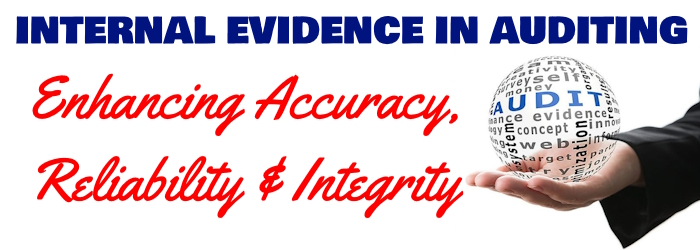Crucial Role of Internal Evidence in Auditing: Enhancing Accuracy, Reliability, and Integrity
Table of Contents
Introduction
Auditing plays a critical role in ensuring the accuracy, reliability, and integrity of financial statements and other information within an organization. To achieve this, auditors rely on a combination of external and internal evidence. While external evidence comes from independent sources outside the organization, internal evidence emerges from within the entity being audited.

Understanding Internal Evidence
Internal evidence encompasses all the relevant information available within an organization, including its systems, processes, and documentation. It offers auditors an inside view of the entity’s operations, enabling them to assess the effectiveness of internal controls, identify potential risks, and detect any misstatements or irregularities. Internal evidence is an essential component of a comprehensive audit as it provides direct insights into the organization’s financial health and operational efficiency.
Types of Internal Evidence
Internal evidence takes various forms and can be categorized into the following types:
Documentary evidence
This includes written records, such as financial statements, invoices, contracts, and internal policies and procedures. These documents serve as vital sources for auditors to verify the accuracy and completeness of financial transactions and assess the adherence to internal controls.
Physical evidence
Physical evidence refers to tangible assets, such as inventory, equipment, and property. Auditors examine physical evidence to ensure their existence, valuation, and proper recording in the financial statements. Regular physical inventory counts and asset inspections are conducted to confirm their presence and condition.
Analytical evidence
Analytical evidence involves the use of financial and non-financial data to evaluate trends, ratios, and other indicators of an organization’s performance. By analyzing these patterns, auditors can identify anomalies, potential misstatements, or unusual fluctuations that require further investigation.
Electronic evidence
In the digital age, electronic evidence has gained significant importance. Auditors rely on electronic records, databases, and systems to validate the accuracy and reliability of financial data. They evaluate the effectiveness of internal controls over electronic systems, such as access controls, data backup procedures, and encryption methods, to ensure the integrity and security of electronic evidence.
Importance of Internal Evidence
Internal evidence holds immense significance in the auditing process for several reasons:
Risk assessment
Auditors rely on internal evidence to identify and evaluate the risks associated with an organization’s operations. By understanding the internal control environment, auditors can assess the effectiveness of controls in mitigating risks and determine the extent of substantive testing required.
Detection of fraud and errors
Internal evidence helps auditors detect fraud and errors within an organization. By analyzing financial transactions, examining supporting documentation, and conducting data analysis, auditors can identify inconsistencies, unusual patterns, or potential manipulations.
Evaluation of internal controls
Internal evidence allows auditors to assess the design and operating effectiveness of an organization’s internal controls. This evaluation helps auditors determine the level of reliance they can place on these controls when planning the audit procedures.
Validation of financial statements
Internal evidence plays a crucial role in validating the accuracy and completeness of financial statements. By examining internal records, transactions, and documentation, auditors can confirm that the financial statements fairly present the entity’s financial position and performance.
Compliance verification
Internal evidence assists auditors in verifying compliance with laws, regulations, and internal policies. By examining internal records and procedures, auditors can identify any non-compliance issues and recommend corrective actions.
Challenges and Considerations
While internal evidence is invaluable to the auditing process, there are several challenges and considerations auditors must keep in mind:
Reliability and bias
Auditors need to assess the reliability and objectivity of internal evidence. There is a risk of bias or manipulation within an organization, which may impact the accuracy of the evidence presented.
Documentation quality
The quality and completeness of internal documentation can vary significantly across organizations. Auditors must ensure that the documentation is sufficient and supports the transactions and assertions being audited.
IT complexity
With the increasing reliance on technology, auditors face challenges in understanding complex IT systems and evaluating electronic evidence. Specialized knowledge and expertise in IT auditing are essential in addressing these challenges.
Access to information
Auditors may encounter difficulties in obtaining access to certain internal evidence, especially when dealing with sensitive or confidential information. Clear communication and cooperation with management are crucial in overcoming these barriers.
Auditor’s role in verifying internal evidence
The auditor’s role in verifying internal evidence is crucial in the audit process. Verifying internal evidence involves assessing the accuracy, completeness, and reliability of the information available within an organization. Here are the key aspects of the auditor’s role in verifying internal evidence:
Examination and Inspection
Auditors examine and inspect internal evidence to ensure its accuracy and reliability. This involves reviewing documents, records, and transactions, such as financial statements, invoices, contracts, and internal policies and procedures. By carefully scrutinizing these documents, auditors can verify the consistency of information, confirm the existence of transactions, and identify any discrepancies or irregularities.
Substantive Testing
Auditors perform substantive testing procedures to obtain evidence about the accuracy and validity of specific account balances or classes of transactions. These procedures can include vouching, which involves tracing transactions from source documents to the financial statements, and reperformance, which involves independently reperforming calculations or processes to confirm their accuracy. Substantive testing helps auditors verify the integrity of internal evidence and assess the overall reliability of financial information.
Data Analysis
With the increasing reliance on technology and the availability of large datasets, auditors use data analysis techniques to verify internal evidence. By applying data analytics tools and methodologies, auditors can identify patterns, trends, and anomalies in the data. This allows them to gain insights, assess the reasonableness of financial information, and identify potential risks or errors.
Confirmation Procedures
Auditors may use confirmation procedures to obtain direct external verification of certain internal evidence. For example, they may send confirmation requests to third parties, such as banks or suppliers, to confirm the accuracy of account balances or the existence of contractual arrangements. Confirmations provide independent evidence that supports the reliability of internal evidence.
Evaluation of Internal Controls
Auditors evaluate the effectiveness of internal controls in verifying internal evidence. They assess the design and operating effectiveness of controls that are relevant to the audit objectives. This evaluation includes testing the controls to determine if they are adequately designed, implemented, and functioning as intended. By assessing internal controls, auditors can gain confidence in the reliability of the internal evidence generated by the organization’s systems and processes.
Professional Skepticism
Throughout the verification process, auditors apply professional skepticism, which involves questioning, challenging, and critically assessing the internal evidence presented. They maintain an independent and objective mindset, considering the possibility of fraud, errors, or management bias. Professional skepticism helps auditors ensure that the internal evidence is thoroughly examined and validated.
Conclusion
Internal evidence forms the backbone of the auditing process, providing auditors with critical insights into an organization’s operations, internal controls, and financial health. It plays a pivotal role in risk assessment, fraud detection, control evaluation, financial statement validation, and compliance verification. However, auditors must remain vigilant about the reliability and objectivity of internal evidence, ensuring its quality, addressing IT complexities, and overcoming barriers to accessing information. By effectively leveraging internal evidence, auditors can enhance the accuracy, reliability, and integrity of the audit process, thereby strengthening the assurance provided to stakeholders.

